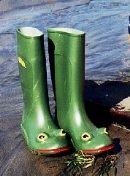At the start of lecture, the professor put up a few cute-related questions on her powerpoint. This set caught my attention, and is now buzzing in my brain:
"Why might cuteness have been so attractive to people living in early 20th century America or Europe? Why are we invested in children’s cuteness as a culture?"
I've been thinking about nostalgia a lot, and also about reception theory, and so this pair of questions set off all kinds of bells and whistles and whirling lights.
First of all: Cuteness is a thing that happens in the audience. There has to be someone looking (or listening, or reading) for a thing to be cute, because cute is in the eye of the beholder. Yes, there are all kinds of studies trying to science-ize why I enjoy looking at baby pandas, but - as with many psychology studies - I am skeptical. Cuteness is a construct that happens outside of the thing or creature "being" cute.
Which brings me to the second point, which was actually raised (sort of) by a student in the fall: cuteness HAS TO BE unintended. The second a child (or anyone) starts trying to be cute, trying to perform cuteness, it ceases to be cute. I think this is one of the reasons people find *Toddlers & Tiaras* so unsettling - it's an endless stream of very determined, conscious efforts to be cute.
Because...cuteness is "natural." It isn't, almost definitionally cannot be, something you do on purpose. It's un-self-conscious. It's "authentic." Perhaps most importantly, it's not manipulative. Cuteness, and the cute, can be manipulated, for sure - this is how advertising works - but it cannot originate in a place of intention. It has to be natural and authentic and unprompted, unscripted. Cute stops as soon as a script or intention can be detected.
Cuteness is non-functional, non-utilitarian. Those same kinds of studies which I regard skeptically occasionally suggest that we find babyness (big head, big eyes, roundness) cute so we don't just throw our offspring into a river when it starts shrieking, but even for me this seems hopelessly cynical. Biological imperative for survival keeps humans, like most animals, from eating their young (so to speak); I don't think panda mothers hang on to their absurdly small panda cubs because the mothers are ga-ga for big round eyes.
But because cuteness comes from a place of no intent, it is never selfish, always selfless, always a kind of gift or benevolence. The only thing cuteness does, in a functional way, is make the viewer feel good. Good can mean amused, or content, or pleased, or amusedly perplexed, or surprised, or satisfied - but it's not a productive response. Cuteness is not productive. It doesn't make or do anything until it's manipulated by a third party (and then it can do almost anything).
So in the 20th and 21st centuries, when we're as industrialized and mechanized and computerized as we've ever been, when humans feel increasingly isolated or alienated from themselves and other humans, when everyone with the wealth privilege to experience it is feeling the many pressures of modernity, a thing that is not manufacture, non mechanized, non technological has tremendous appeal. There's a lot of buzz about "the search for authenticity," blah blah, but that drive to locate something real in a world that feels chock-full of artifice is very strong. The fact that authenticity is as much a construct as anything else is beside the point (for the moment, anyway).
Cuteness isn't manufactured, and it doesn't ask anything of us except that we enjoy it. It's also got the weight of nostalgia, and all the unattainable longing that nostalgia carries with it. Since cuteness is unconscious of itself, we can never BE cute, or be the cute. We can, perhaps, recognize our past cuteness - look at a photo of yourself from when you were three or four or six, or listen to a parent or someone recount a charming story of something you said or did when you were a child; it's eminently possible to see cuteness there. But in the moment of the Cute-ing, the Cute cannot recognize itself as cute. And because it can't be intentional, we can't plan to be cute in the future (though we may be). So our own cuteness is always, forever, constantly retrospective; it is always something we cannot ever have or be. Cuteness, in a weird way, is always vicarious. Cuteness is a reaction, a response. In our nostalgia-saturated culture (see Svetlana Boym for some brilliant work on nostalgia), cuteness is another mode for our nostalgia to work in, or on; that intense, desperate longing for the thing which can never be again, maybe never wasto begin with, is at the core of nostalgia; it is identical to the way in which we are positioned in relationship to our own cuteness. We can never have it (again), we can never intentionally do it, we can only mourn its loss and furiously desire to have it. It has to be experienced vicariously, so we seek it out, and when we find it, we fawn over it.
I am not sure that I would argue - not yet, anyway - that cuteness is harmful to children or adults. I just don't know. I don't think cuteness has to be, or can only be, exploitative - it's how that cuteness is deployed and maneuvered that becomes the problem, but that, as I suggest, doesn't reside in the thing of cuteness itself. Still, it's an interesting and probably vexed (if not more disturbed) set of relationships and conditions that circulate around cuteness and The Cute and the viewer of that cuteness.




1 comment:
Post a Comment